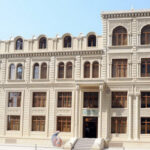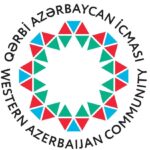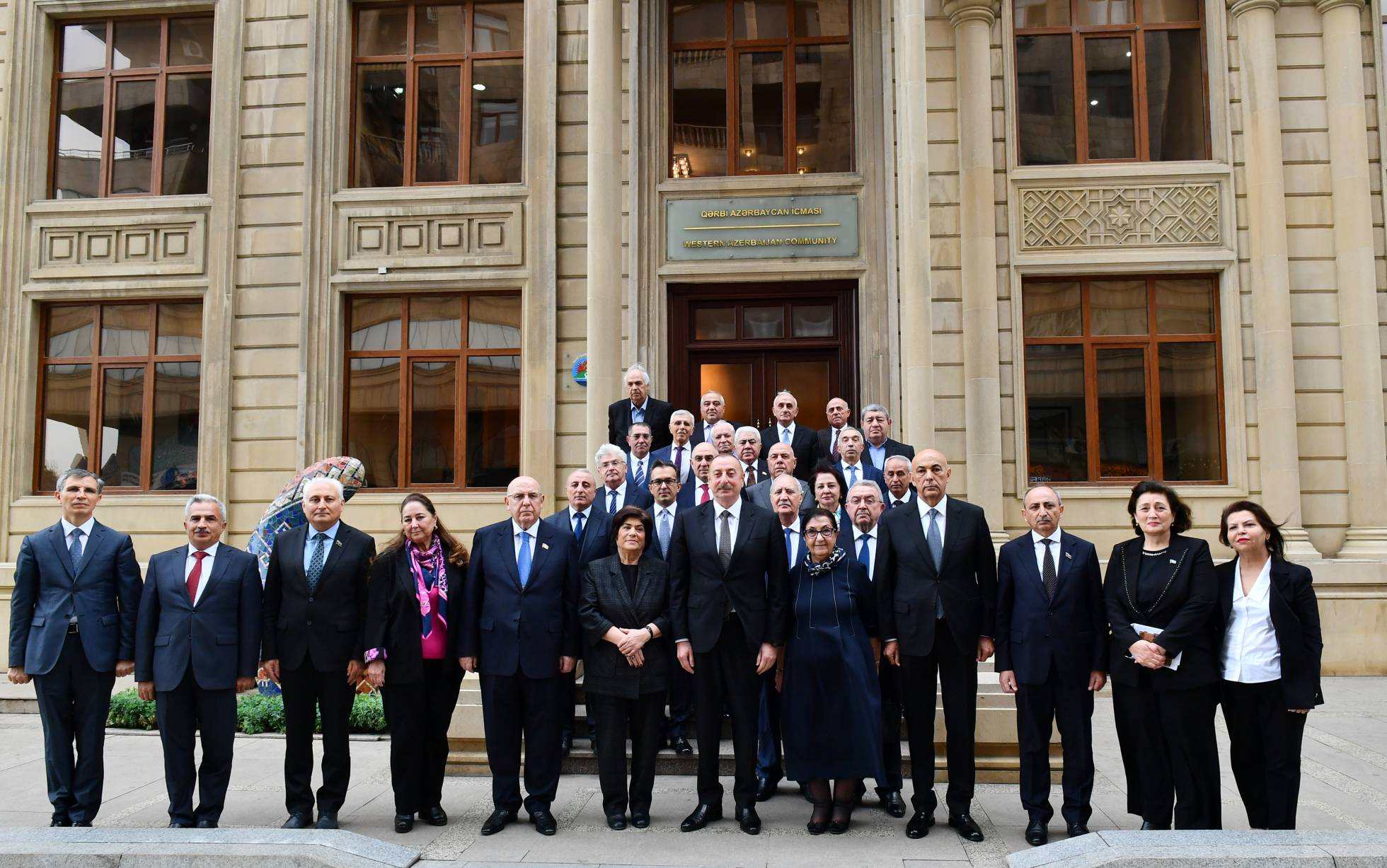President Ilham Aliyev last week attended the inauguration of the administrative building of the Western Azerbaijani Community, an organization representing Azerbaijanis who were forcibly displaced from the territories of Western Azerbaijan that form modern-day Armenia.
The former headquarters of the Azerbaijan Refugee Society, which was repurposed to host the Western Azerbaijani Community, presents historical data, maps, and artifacts of the life of Azerbaijanis before and after their displacement from their ancestral lands by Armenian authorities.
“Western Azerbaijan is our historical land, which is confirmed by a number of historical documents, historical maps and our history itself. Unfortunately, as they did in Karabakh, the Armenians razed all our historical and religious monuments in Western Azerbaijan to the ground. They wanted to erase the historical heritage of the Azerbaijani people, but they failed,” President Aliyev said in a meeting with the members of the Western Azerbaijan Community after the building’s inauguration, his press service informs.
“Because there is history, there are documents, and there are maps. The map displayed in this building, dating back to the beginning of the 20th century, once again shows that Western Azerbaijan is the historical land of Azerbaijan. The names of cities and villages are of Azerbaijani origin, and we know perfectly well that the Azerbaijani people lived across present-day Armenia throughout history.”
President Aliyev added that the 20th century was associated with great tragedies for the people of Azerbaijan forcibly expelled from their ancestral lands. According to him, the Azerbaijan Democratic Republic “practically presented” Azerbaijan’s historical city of Iravan (modern-day Yerevan), to Armenia in 1918, and in 1920, the Soviet government severed the Zangazur region from Azerbaijan and annexed it to Armenia. The president labeled these events as a “crime” against Azerbaijanis.
“Finally, in the late 1980s, the Soviet government committed another crime against our people … Azerbaijanis were deported from their historical lands in Western Azerbaijan. We also know the number of places where Azerbaijanis lived – more than 170 villages were populated solely by Azerbaijanis. I am talking about Armenia, the Republic of Armenia. The Azerbaijanis accounted for the majority of another 90 villages. At the time, Azerbaijanis had lived in more than 300 towns and villages across Armenia. All of them were forced out over the course of three years. They were expelled, and many of them were killed and tortured. All these crimes were taking place with the collusion of the Soviet government. Our last village, Nuvedi, was subjected to deportation in August 1991.”
He said the rights of Western Azerbaijanis must be restored and added that they should be allowed to return to their native lands through peaceful means. President Aliyev pledged that the state bodies will continue to support the Western Azerbaijan Community and further instructions will be issued to communicate the realities to the world community.
Western Azerbaijan
The historical lands of Azerbaijan on the country’s western edge has been originally settled by ethnic Azerbaijanis before they were included in a destructive plan developed by the Soviet authorities. The city of Iravan (modern-day Yerevan) and the Zangazur region was one of the cradles of the Azerbaijani population and culture before their forcible separation from the Azerbaijan Democratic Republic (ADR) in 1918 and 1920, respectively.
Iravan had been initially settled by ethnic Azerbaijanis after its establishment by their ancestors. Although Iravan was handed over “willingly” to the newly established Armenian state by the ADR government, historical sources claim it to be organized and implemented forcibly under the pressure of foreign forces.
Zangazur is a historical region that forms the southern part of modern-day Armenia and a small portion of the territory of Azerbaijan in the country’s Zangilan, Gubadli and Lachin districts.
The Zangazur region, inhabited by the Turkic tribes, was a part of the Seljuk empire during its 150-year-long rule in the 11th and 12th centuries, which further expanded the Turkish-Islamic influence within the region. Starting from the 13th century, Zangazur was invaded by Mongol-Tatar tribes and the Timurid Empire. From the 15th century to the 18th century, the region was a part of the medieval Azerbaijani states of Garagoyunlu, Aghgoyunlu, and Safavids.
Demographic changes in the city of Iravan and the Zangazur region took place during the reign of Tsarist Russia and the Soviet Union. A massive long-term relocation of Armenians by the Russian Empire to Iravan, Zangazur and other territories of Azerbaijan started in the wake of the Russian Empire’s victory over Iran in two wars in the 1804-1812 and 1826-1828 war. A special commission was established to deal with the deployment of Armenians from Ottoman and Iranian territories to the South Caucasus. As a result of the relocation, the number of Armenians in the Karabakh region of Azerbaijan reached 18,000 between 1828 and 1829 and increased to 34,606 by 1843. The next wave of deployment of Armenians into the South Caucasus by Russia lasted from 1904 to 1915, when over 260,000 ethnic Armenians were placed in the territories of Azerbaijan. Despite protests, around 130,000 Armenians were relocated to the Azerbaijani provinces of Iravan and Yelizavetpol (the name of Azerbaijan’s Ganja city during Tsarist Russia’s period).
As a result of the massacres committed by Armenian armed groups in 1905-1907 and 1914-1920 in Zangazur, about half a million indigenous Azerbaijanis and other Muslim locals were killed. In those years, 115 Muslim villages in Zangazur have been wiped off the face of the earth.
Iravan was ceded to the newly-established Armenian republic on May 29, 1918. Shortly after the Bolshevik forces subjugated the Azerbaijan Democratic Republic on April 28, 1920, a significant part of the Zangazur region was also ceded to the newly-established Armenian Soviet Socialist Republic on November 30, 1920. The annexation of the territories by Armenia took place under the aegis of the Soviet empire, which forced the Azerbaijani authorities to make territorial concessions to Armenians. As a result, Nakhchivan became an exclave separated from the Azerbaijani mainland.
The annexation of Iravan took its toll on its indigenous Azerbaijani population and the cultural heritage of Azerbaijanis. According to 1916 data, there were over 373,000 Azerbaijanis living in Iravan, however, only 12,000 Azerbaijanis were registered in census files in 1922.
In 1933, the territory of the Armenian SSR was divided into districts and the name Zangazur was changed to new district names such as Gafan, Gorus, Garakilsa (Sisian), and Mehri.
The final round of the “Armenianization” of Western Azerbaijan took place in 1988 when over 300,000 ethnic Azerbaijanis living in the historical Western Azerbaijan region, or modern-day Armenia, were expelled forcibly from their ancestral lands. The anti-Azerbaijan sentiments in Armenia were then on the rise accompanied by pogroms and persecution of ethnic Azerbaijanis. The motives for the ethnic conflict were Armenia’s illegal claims for the territories of Azerbaijan, namely the Karabakh region. The deportation of Azerbaijanis later set grounds for Armenia to launch a full-scale military attack on Azerbaijan, leading to the first Karabakh war in 1991-1994 and the occupation of the internationally recognized Azerbaijani lands.
Cultural vandalism
In May of this year, journalists from Baku-based Caliber.Az news service traveled to Armenia’s capital Yerevan to reveal the unforeseen cultural genocide against the Azerbaijani heritage in the city.
The state-sponsored cultural vandalism in Yerevan was a part of the large-scale anti-Azerbaijan campaign aimed at erasing all material evidence that testify to the belonging of the city to Azerbaijanis. According to Caliber.Az, at the beginning of the 20th century, there were 310 mosques registered on the territory of the Iravan province (modern-day Yerevan and northern parts of Armenia). However, today only one mosque can be seen in the city – the Goy Masjid (Blue Mosque), which is referred to as “Persian”.
Furthermore, the Demirbulag Mosque, the Emir Saad Mausoleum, the Sardar Mosque, the Tepebashi Mosque, and dozens of other cultural and religious monuments of Azerbaijanis have not survived the pre-planned cultural vandalism by Armenia.









